#why is an alien familiar with roman terminology
Photo

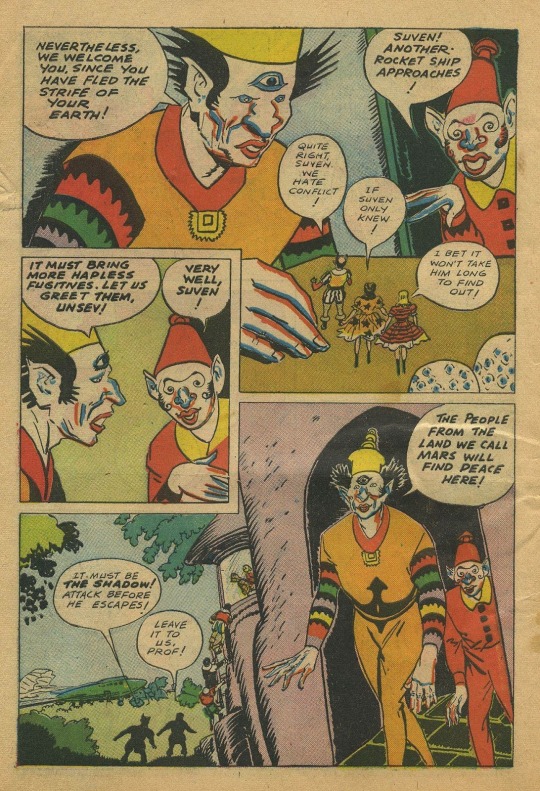

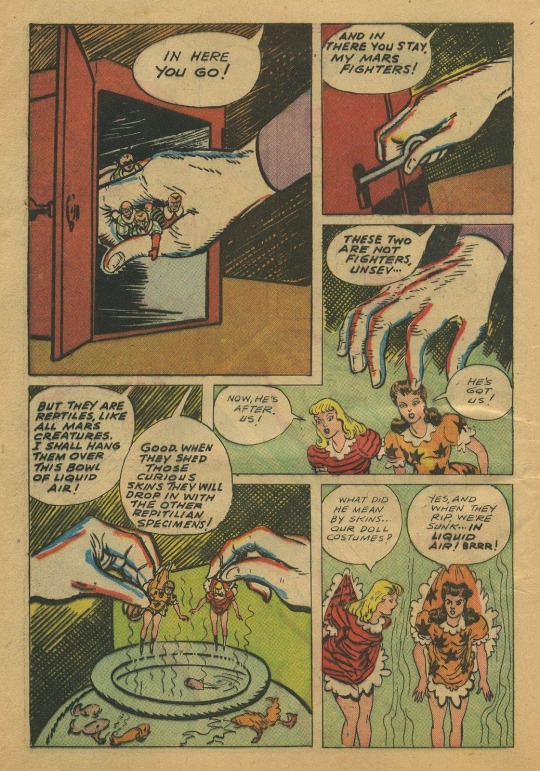

#the shadow#shadow comics#there is a lot to unpack here#why is an alien familiar with roman terminology#so is the comics shadow earth called mars elsewhere#did these guys come before or after humans#does this mean technically the shadow lives on mars#i never thought i'd get to see the shadow encounter clown gods from venus#i never thought i'd have to write that sentence#holy shit he tried to boil margo alive#i think this may be the most terrifying shadow villain of all time#what can possibly prepare you for a giant clown king of venus who wants to boil you alive because he thinks he's doing you a favor#protectospheres#jesus christ#i wish the rest of the golden age shadow comics were this weird
2 notes
·
View notes
Text
The weirdest Shadow villain of all time

From Shadow Comics #40
For the most part, Street & Smith’s 1940s Shadow Comics were forgettable and dull, largely comprising of adaptations of radio episodes but devoid of atmosphere or humor, it’s hard to even believe Gibson wrote them. It’s a 100% sanitized family friendly American Hero Shadow with little bite or personality, really just another mediocre Golden Age superhero comic for the most part.
But every now and then, those comics would get real, real weird with what they could get away with. They’d just go full-in on fantasy storylines that were unfeasible for the pulps and radio, and pit The Shadow against the weirdest villains he’s ever encountered. The Shadow vs Solaris was a three-issue story arc where The Shadow battles a mad scientist named Solaris who uses a shrink ray to transport convicts under his employ (as well as a captured Margo and Valda Rune) into the planet Venus so he can flee the authorities on Earth.
Solaris is not the abominable clown monster menacingly hovering above The Shadow in that image. No, that’s Suven, a character who only appears for one issue, and never again. Perhaps for the best, as we'll see below:
After Solaris and his crew arrive on Venus, they are approached by transparent bell-like living beings. Some of the convicts attack the bell things, so they capture all of the crew and transport them to a palace surrounded by thunderstorm. There, they meet Suven, the Ruler of Venus
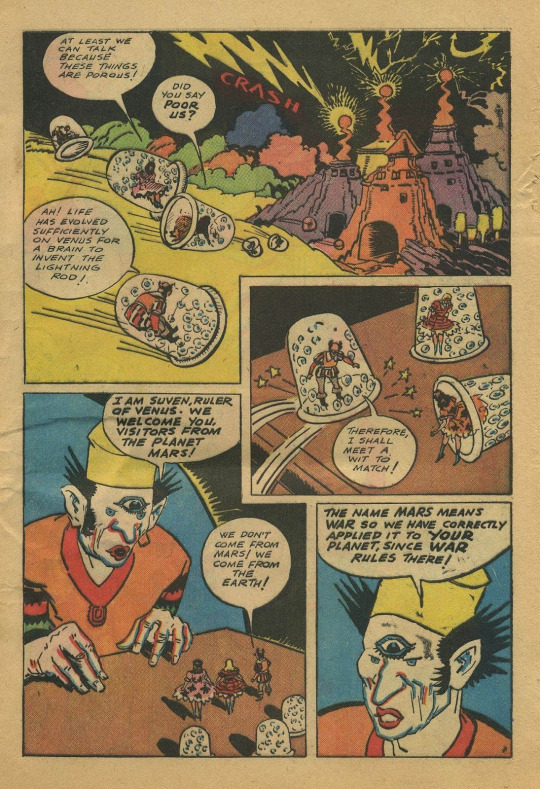
(Who is the "we" Suven is referring to? Why is an alien familiar with Roman terminology? Is the S&S comics Shadow’s Earth called Mars on other planets? Did the rest of the galaxy name Earth “Mars” before we did? Is Suven a bigger authority than the rest of humanity since he rules an entire planet single-handedly and therefore it’s simply us that have been calling the planet wrong the whole time? Does this mean The Shadow technically lives in Mars? One page in and we already got so many questions unrelated to the existence of a THREE-EYED CLOWN KING OF VENUS IN A SHADOW STORY)

Contrary to what the appearence of a gigantic three-eyed monster clown would indicate, Suven is actually incredibly nice, all things considered. He is completely welcoming to these weird, tiny strangers who attacked living beings in his world, whom he knows come from a wartorn world, and eagerly welcomes them as refugees. Suven may very well the most genuinely benevolent ruler of state ever depicted in a Shadow story.
(Why is his friend/servant/partner’s name just Suven’s own name but scrambled? Is everyone on Venus named after anagrams of the planet’s name? That would actually be the most Shadow-appropriate thing of it all, since Gibson did love anagrams and wordplay).
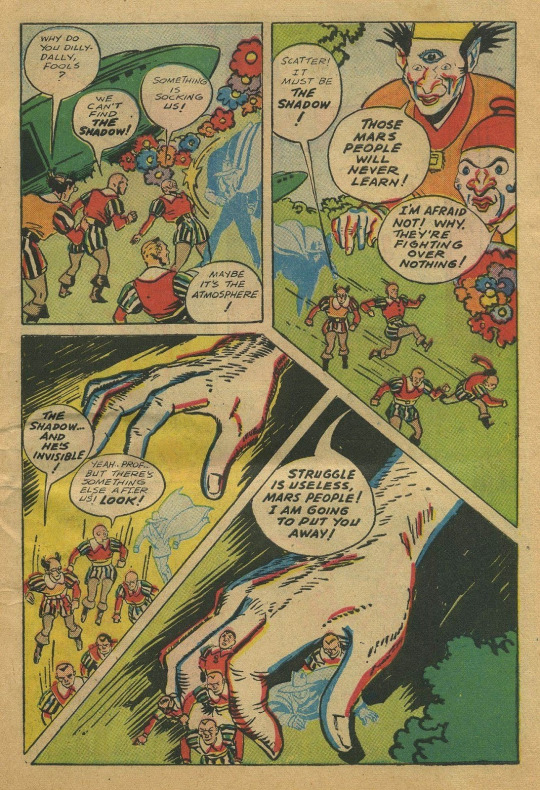
Problem is, Suven is also an alien king who does not know how to interact with humans. In fact, he thinks all creatures on “Mars” are reptiles. And so, his idea of helping them break up conflict is to lock away those rowdy fighters, and help the peaceful ones shed their skin.
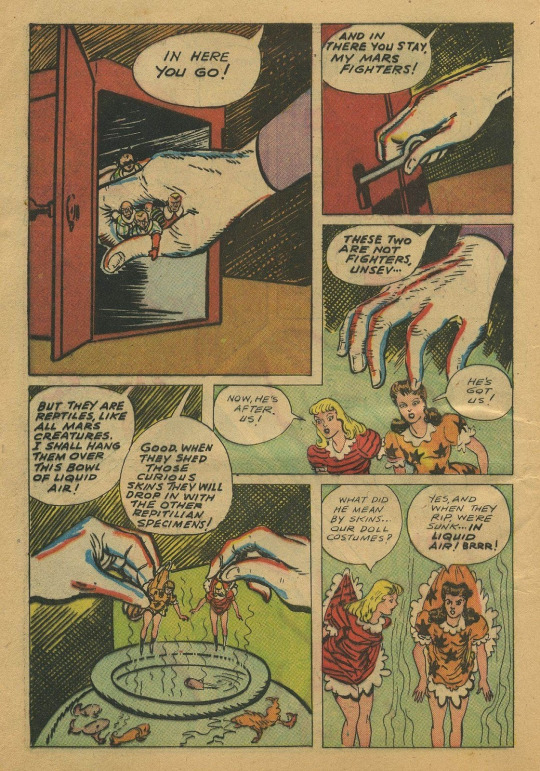
(The other reptilian specimens? If Suven is referring to the monsters in the bowl, does it mean those monsters come from "Mars"? Has he done this to other humans? Has Suven been to Earth before to determine that all creatures are reptiles? He knows enough about it to determine it as a wartorn world, saying the Mars people "will never learn". What kind of contact did he have with the "Mars people" prior to this, then? Why can't he tell clothes apart from skin?)

As expected, The Shadow manages to break free and rescue them in the nick of time. The story ends with them stealing a rocket and flying away from the planet, the first and only time The Shadow was ever forced to flee from someone who put Margo in danger. No climactic confrontations, no, they just nope the fuck out of Venus before Suven comes back. And the Venusians are happy to see those violent intruders gone.
The cover for this particular comic depicts a scene of Margo and Valda held in the grip of a giant while The Shadow prepares to shoot a giant gun to rescue them, although it depicts a green ogre-esque giant instead of Suven. Then again, if we know one thing about supernatural monster clowns, is that they rarely stay in one shape for long. Maybe that’s just what Suven looks like sometimes.
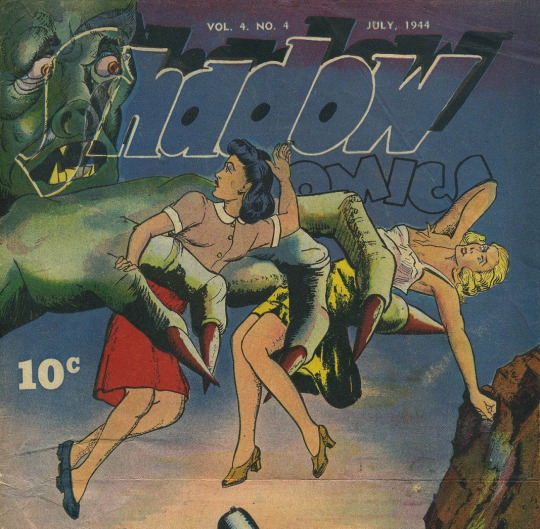
Despite not being truly evil, Suven is possibly the only “villain” in the Shadow’s history posing a danger that The Shadow has never defeated, or even tried fighting. Suven and Venus never appeared again, and the next story of the Solaris arc only mentions that the Venusians kicked Solaris and his crooks out of the planet, which even acts as a catalyst for Solaris’s goons to want to reform.
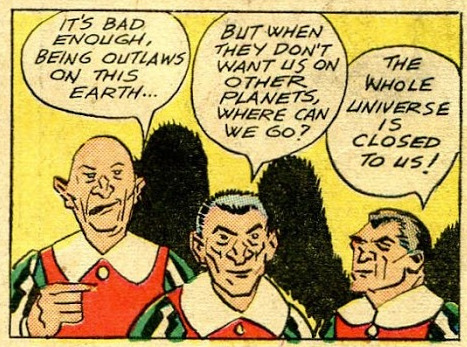
As far as I’m aware, there was only one other story from the S&S Shadow Comics set in outer space, and no other Shadow story since then has ever gone that far outside of Earth. There were aliens in one episode of the radio show who were nothing like those from Venus (and certainly not benevolent), and The Shadow’s had encounters with supernatural beings who live outside of Earth’s bounds, but never in space. Never like this, never again.
For all we know, across all Shadow continuities, Venus is home to a strange ecosystem ruled by a three-eyed clown king (possibly a hivemind of clown kings with anagrams of the same name) who is a really swell, pacifist guy and kind, accepting ruler, with the small caveat that he may try to freeze your skin off thinking he’s doing you a favor.
#the shadow#the shadow essays#shadow comics#all of the diet Cthulhus of Shadow comics don't have shit on this guy#what can possibly prepare you for a giant alien clown king who wants to shed your skin because he genuinely thinks he's helping you#i wish the rest of those comics were this weird
19 notes
·
View notes
Text
A Guide to 40k Naming Conventions
General Notes on Angels, Elves, and Aliens
Our modern, western sense of what an otherworldly entity’s name should sound like--and, thus, the typical 40k fluff writer’s idea of same--draws primarily from a handful of major sources.
First is the body of supernatural fiction written in the 16th and 17th centuries by Christian mystics. The most famous of these texts is the Lesser Key of Solomon, which contains the infamous Ars Goetia--a list of demonic names that has been so ruthlessly plundered by novels, movies, comics, video games, and tabletop RPGs that it’s almost impossible to find a name on it that you don’t already recognize from somewhere else. All of these texts are, themselves, informed by the Bible--specifically, by the Greek and Hebrew transliterations of the many, many local deities that competed with Yahweh in the character’s early incarnations, and were subsequently retconned into being demonic (and thus, formerly angelic) entities. Another mystical name to know is John Dee--a contemporary of Shakespeare who claimed to communicate with angels, and learned from them a vaguely semitic conlang called Enochian, which formed the basis for many subsequent demonic and angelic names.
The second major influence on how the supernatural sounds is, of course, Tolkien--his legendarium, and the several constructed languages it was built around, are nowhere near as old, but their sheer depth and ubiquity has led them to inform our sense of the fantastic ever since they were published. It helps that Tolkien (a language nerd of incredible dedication) deliberately designed the various Elvish languages to be pleasing to the Anglophone ear, and constructed the Black Speech of Mordor to sound especially abrasive and unpleasant to same.
Both of these cultural touchstones, of course, are in turn rooted in the structure of English itself--which, simply by being familiar to its speakers, also establishes a set of linguistic elements that come across to us as unfamiliar. You can see this both in the way we parse certain other languages--like Latin and Hebrew, which each carry cultural connotations that color anything we read or hear in them--and how we try to make words and sounds that feel fundamentally ‘other.’ This is why the cliched evil space lord always has a name like Zorblax or Glorbitron or something equally silly; all those Xs and Zs and -or sounds stick out to us as obviously not-from-around-here, both because they show up so rarely in English and because they’ve been so heavily used in other, earlier “outsider” names. In short, they are the Space Noises--learn to love them.
Space Marines
The Astartes are a ridiculously diverse bunch--culturally, at least--and a full accounting of the naming conventions of every major chapter would be a paper in itself. A few trends, however, do stick out across the vast sea of pauldrons that makes up the face of 40k.
Firstly, they tend to default to a slightly generic Greco-Roman theme, with little regard for correct Latin conjugation or (in some cases) the actual established naming practices of a chapter.
Canon: Lucius; Gaius; Titus; Vitus; Julius; Marius; Cornelius; Galba; Otho; Vitellius; Vespasian; Erasmus; Odenathus; Pertinax.
Original: There aren’t any. They’re all taken. Every single one.
Secondly, Black Library loves their Goetia; since space marines are angels of death, and lists of demons are by definition lists of angels, the writers of 40k have given themselves carte blanche to sprinkle Hebrew and Enochian (or just Hebrew- and Enochian-sounding) names across the galaxy.
Canon: Azrael; Asmodai; Belial; Mephiston; Astorath.
Original: Also all taken by one franchise or another, but a few more obscure names, like Focalor and Paimon, haven’t been used for Astartes. Yet.
Thirdly, a few chapters, like the Salamanders, draw on a sort of implicit language (an “implang,” as I’ve started calling it just now and nobody can stop me) for their names; not a fully developed conlang, but a set of phonemes and syntactic conventions unique to that chapter, which evokes a shared culture without laying out the specifics of how their language or society works.
Canon: Tu’shan; He’stan; K’gosi.
Original: Nar’tesh, 3rd Company Lieutenant and famous ASMRtist.
Chaos Space Marines
Traitor Astartes sometimes follow the same general pattern as their loyalist cousins--but they rely more on Greek and Hebrew for their inspiration, use a good deal more Space Noises, and are much more likely to dip into a legion-specific implang.
Word Bearers, in particular, mix Mesopotamian and north African influences with their own Colchisian conventions to create characters that people raised in a Christian milieu can identify as baby-eating diabolists just by reading their names.
Canon: Eliphas; Sor Bakphal; Ankh-Heloth; Marduk.
Original: Tal Berath; Usor-Kehelit; Kor Lugash.
Iron Warriors love imposing sounds that evoke statuary, sieges, and lumbering prehistory, and mix a little German in for extra industrial dehumanization.
Canon: Berossus; Barban Falk; Promodon; Volk.
Original: Tallisk; Cullus Rieg; Idric Therion.
Night Lords have a particularly developed implang, thanks largely to Aaron Dembski-Bowden--there are no concrete rules, but Nostraman names and speech are very evocative of who they are and where their screwed-up childhoods happened, combining soft and harsh syllables to eerie effect. Also, bats. Batsbatsbatsbatsbats.
Canon: Jago Sevatarion; Kellenkir; Uzas; Gendor Skraivok.
Original: Mithrak; Delekiir Surmod; Tadarias.
Chaos Daemons
By the time the actual otherworldly entities of this setting got to the big pile of public domain names, the Astartes had already made off with almost every resource traditionally used for malevolent spirits and the like--so the servants of the Ruinous Powers have had to make do with bespoke names furnished for them by GW's finest edgelords. In general, this means a wild grab bag of Space Noises and more apostrophes than an Austronesian phone book--but certain trends do emerge among the followers of the different Chaos Gods. Supposedly, daemonic names are often tied to their patron deity’s sacred number, but this is rarely adhered to in the fluff.
Khornate Daemons tend to have names that sound like synonyms for anger or types of wounds, like “wrath” or “scar” or “gore.” As the daemons most likely to look and act like Balrogs, they’re also the most likely to have names that sound like Morgoth came up with them. When all else fails, just fall back on the dumbest edgy nineties bullshit you can come up with.
Canon: Skarbrand; Ka’bandha; Hakk’an’graah; An’ggrath; Doombreed.
Original: Rath’gor; Bludskar the Irritated; Skullgoroth Bloodmassacre (Blood Lord of the Skulltaking Goremurderers of Violenceheim).
Slaaneshi Daemons are soft, sensuous, and sibilant, evoking corrupting luxury and puritan sexual terror. They’re ostensibly sexually ambiguous, but they tend to come off as feminine, because only women can be evil and sexy at the same time--at least, before the watershed.
Canon: Luxuria(!); Mistress of Spite; N’Kari; Lushcrix Lashtongue; Kyriss.
Original: Sulatari; Ivress; Scivia the Weirdly Wholesome (secret identity of @jetblackraider).
Nurglite Daemons evoke medical terminology and bodily effluvia, and are the only breed of daemons whose names are even more extra than Khorne’s.
Canon: Epidemius; Horticulous Slimux; Rotigus; Scabeiathrax the Bloated; Maggotgurgle fucking Pukeslime I swear to god that is actually a real character.
Original: Count Thergothon (Lord of the Chronic Court and certified tax attorney); Phagovile the Viscuous; Gribbulous Taintsac (Founder of the Gribbulous Taintsac Institute for Excessive Medical Horror, and head of the accreditation board for Death Guard Plague Surgeons).
Tzeentchian Daemons often have Egyptian-sounding names--or, at least, Egyptian as transliterated into Greek, which is the way most people know the Ancient Egyptian language. They also have the highest letter-to-apostrophe ratio of any Daemon breed.
Canon: Kairos Fateweaver; K'tzis'trix'a'tzar; Aetaos'rau'keres; Shim'dre'lex'kazar.
Original: Azoth Flickerflame; Kheper’atos; Ix’il’kak’iz’it’xyk’ik’ak’it’l’zy’xyx the Unpronounceable (holds the current record for most planets destroyed by failed summoning attempts).
Aeldari
The original name of this faction was lifted directly from Lord of the Rings--in fact, one of the most iconic themes in the movie soundtrack is literally called "The Host of the Eldar." Accordingly, the majority of the sounds and conventions that go into an eldar name come from the Tolkien legendarium (and the many other fantasy worlds that have sprung up around it), with the occasional angelic or Space Noise element--but there’s also a good dash of both Vedic and European pagan (or at least, reconstructed Romantic-era neopagan) mythology mixed into their lore, and allusions to such sometimes pop up in their names as well. In particular, it’s normal for Craftworlds to be named after either goddesses we stopped praying to or holidays we stopped celebrating.
Canon: Eldrad Ulthran; Taldeer; Yriel; Mauryon; Craftworld Biel-tan; Craftworld Os’tara.
Original: Gilthoniex (ranger of Ulthwe who died of shame after being tricked into starring in Drukhari cuckold porn); Athembra (Iyanden Farseer who follows Tyranids around and narrates their behavior in a posh British accent).
Drukhari
The Dark Eldar are a modern take on the Fair Folk--both directly by way of being decadent evil elves, and by the more roundabout route of being alien abductors with a thing for weirdly sexy science-torture--and their lexicon reflects this by replacing the Quenya- and Sindarin- inspired sounds of the Craftworlds with lots of fey, witchy imagery (largely derived from Celtic culture) and a more sibilant, angular set of Space Noises. They also help themselves to a bit of Sanskrit and Enochian--but with a demonic slant where their cousins might have a hint of the angelic.
Canon: Asdrubael Vect; Lelith Hesperax; Kheradruakh the Decapitator; Arhra.
Original: High Excruciator Ekritar (rose to become Archon of the Kabal of the Ludicrous Edge thanks to a body of spectacularly depraved PornWeb videos); Rinatha Heartrend (Prima Succubus of the Cult of the Severed String, the Dark City’s foremost NTR specialists);
Necrons
Necrons are Egyptian space robots. That’s really all there is to it.
Okay, so there’s a little more to it. Necrons draw on Egyptian themes--but like Tzeentch Daemons, it’s Egypt as parsed through Classical Greece. The heyday of Egypt occurred during the misty prehistory of Greek civilization--Pharaohs like Thutmose III and Amenhotep III knew of, and traded with, the Mukinu (Mycenaeans) on the opposite shore of the Mediterranean, but serious diplomatic contact was fairly limited. By the time the Greeks started writing anything down about the Egyptians, it was the 5th century BC, and Egypt’s sun had set. Greeks like Herodotus knew it primarily as a fading power--a helpless subject of one empire after another, fought over by foreign kings in the shadow of crumbling pyramids that nobody even remembered how to build.
Because our idea of Egypt was, for centuries, mostly informed by Greek sources, a lot of people and places have been transliterated from Egyptian to Greek--so gods whose original names were closer to User, Sutih, and Heru became popularly known as Osiris, Seth, and Horus, respectively. This slight detachment between the pop cultural image of Ancient Egypt and their actual spoken language is why Necron names can sound as much Greek as Egyptian--and sometimes, they roam even further into the Balkans and start rummaging through the Baltic and Slavic language families for spare phonemes. They also tend to be studded with Space Noises of a particularly electronic nature.
Canon: Szarekh; Imotekh; Anathrosis; Trazyn; Varagon Drakvir
Original: Nefertronus; Inenoth; Tombworld Per-Ma’akh
Orks
Like the space elves, the space orcs draw heavily on Tolkien--but they eat the hot dog from the other end, with names rooted in the Black Speech and a penchant for vaguely problematic thuggery. Orks, like Uruk, are horrible brutes who exist mostly to die in vast, anonymous hordes at the hands of a protagonist.
Unlike Uruk, Orks are funny.
Yes, I’ve read The Beast Arises. Yes, I remember the dead civilians in Space Marine. The occasional serious outing is simply the exception that proves the rule: Orks are as much British football hooligans as they are the hosts of Mordor, and every time they take center stage, it’s as shamelessly wacky comic relief that's equal parts mad science and Mad Max. Orks are the demented lovechild of Wile E. Coyote and the Mythbusters, and I love them dearly for it.
To make an Orkish name, start with either a few Mordor-ish syllables or a descriptive sobriquet, and record yourself shouting it while (timing is very important here) you’re drunk enough to fight a mailbox, but sober enough to walk away when you lose. Orks have lots of hard G and K sounds and long vowels, giving you all sorts of opportunities to shout at people and hit them over the head--and if you’re not doing either of those things, you’z not speakin’ Ork proppa, ya git.
Canon: Nozgrot; Snagga-Snagga, Wazdakka Gutsmek, Ghazghkull Mag Uruk Thraka.
Original: Killdoza (voted Best Cuddler in the Calixis Sector fifty years running, but mostly because only gretchin are smart enough to actually spell 'Calixis Sector'); Goffmawg (once stole an ultraberry pie from Marneus Calgar's windowsill); Lugnutz Boomkrasha (semi-mythical mekboy active during the Great Crusade, said to still be hurtling through interstellar space, clinging desperately to a planet-cracking warhead aimed in the general direction of Segmentum Solar).
Tau
The Tau ostensibly have their own codified naming scheme--but before that was laid down, they inevitably developed a handful of characters with silly alien-ized versions of famous Asian names. Modern Tau names are usually assembled from long sequences of one-syllable words, in imitation of the modular logograms used in Chinese and Japanese writing. Unfortunately, as it’s currently implemented, it’s kind of shallow, and there isn’t much room for different names--as evidenced by the number of Tau referred to as “Kais” in various media, some of whom are different people and some of whom aren’t.
It’s sad, honestly. There’s so much potential here, and they don’t even scratch the surface--even without leaving the Sino-Japanese Sphere of Generic Asian-ness, there’s all sorts of fascinating, lyrical things you could do with a naming scheme like this, but there’s, like, six Tau books and everyone in them is either a noble space-samurai or an inscrutable space-mandarin, so they’re all one syllable apart.
Canon: El’Myamoto, El’Hassai, Shas'la T'au Kais, Shas'O Kais, Shas'O Vior'la O’Shovah Kais Mont'yr, Aun’Va, Aun’Vre, Aun’Shi.
Original: Por’La Xiu (minor Water caste diplomat and star of the first human-Tau interspecies erotica recorded under the official auspices of the Tau’va), Fio’El Tra Buo’ren (Senior Earth Caste programming director, responsible for developing the endearing behavior subroutines now installed on all frontline drones to prevent frivolous use of the savior protocols), Kor’O Da’he Li’Lian Sou (Revered fleet strategist, architect of some of the greatest space battles of the Second Sphere of Expansion, died in his bed without ever meeting a gue’la).
#warhammer 40k#warhammer40k#40k#40k lore#black library#horus heresy#language#linguistics#naming#guide#rp#oc#space marines#astartes#ultramarines#dark angels#blood angels#salamanders#chaos space marines#heretic astartes#word bearers#iron warriors#night lords#chaos daemons#khorne#slaanesh#nurgle#tzeentch#aeldari#eldar
9 notes
·
View notes